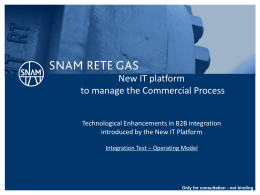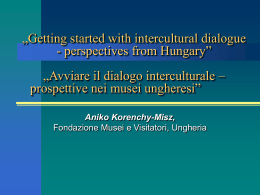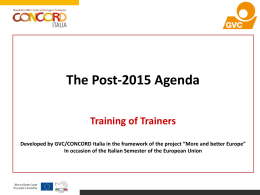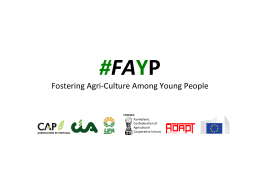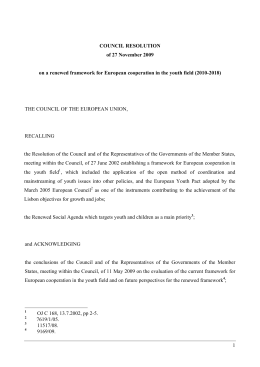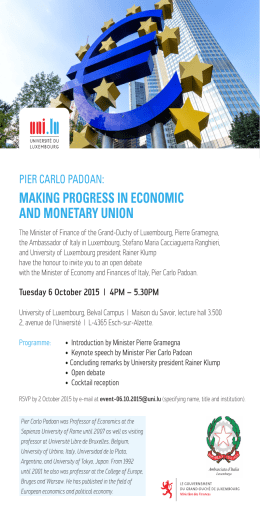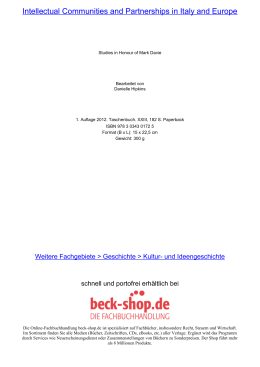Trends in Public Consultation in Canada Prepared for the Parliamentary Centre’s Canada-China Legislative Cooperative Project A Collaborative Effort Between Canadian Policy Research Networks (CPRN) and Ascentum Inc. May 2005 CPRN is a not-for-profit policy think-tank based in Ottawa. It has been using public dialogue for a number of years as a means to involve citizens more directly in research and public policy discussions on issues such as health care reform, quality of life indicators, Canada’s children, aging and the society we want. You can obtain further information about CPRN and its work in public involvement and other policy areas at www.cprn.org Ascentum is an innovative professional services firm with a focus on consulting and technology services. Its diverse customer base lies in the private, public, and not-for-profit sectors. They have a wealth of experience in consultation and dialogue, developing organizational and project oriented strategy and visions, conducting research, analysis and evaluation, and facilitating service and business transformation processes. Dialoguecircles.com is Ascentum's online service offering designed specifically for consultation and dialogue. Please note that CPRN and Ascentum were involved in the design and/or delivery of some of the initiatives outlined in this report. Canadian Policy Research Networks Inc., 600-250 Albert Street, Ottawa, ON K1P 6M1 Ascentum, Inc. 6 Hamilton Avenue North, Ottawa, ON K1Y 4R1 Trends in Public Consultation in Canada Table of Contents Page Executive Summary i 1. Introduction 1 2. Canadian System of Government and Current Context 1 3. Policy Making Lifecycle and Interface of Public Consultation 7 4. Public Involvement Spectrum and Participant Commitment Spectrum 9 5. Principles of Good Public Involvement 10 6. Challenges to Public Involvement in Canada 11 7. “Scaling Up” Public Consultation 12 8. Case Studies 13 9. Conclusions 20 10. References 21 11. Additional Suggested Sources 21 Page i Trends in Public Consultation in Canada Executive Summary In the context of a four year legislative capacity-building project, the Canadian Parliamentary Centre in partnership with China’s National People’s Congress Research Office, is organizing a Canadian study tour for a number of Chinese officials. The focus of the study tour is to explore practical elements involved in planning and implementing public consultations. This briefing paper which precedes the study tour provides an overview of trends of public consultation in Canada and how public consultation relates to Canada’s system of government. The paper sets out the Canadian context in terms of the system, structure and role of government and the constitutional and jurisdictional relationship among the three levels of government (national provincial/territorial and municipal). From the perspective of the federal government, the role of the Prime Minister, Ministers and the public service is outlined as is the relation between the policy making process, including the legislative process and public consultation. In particular, it highlights Canada’s regulatory policy which requires federal departments and agencies to demonstrate that Canadians have been consulted and that they have had an opportunity to participate in developing or modifying regulations before they are approved by the appropriate authorities. The Regulatory Impact Assessment Statements and the Canadian Environmental Assessment Act are presented as two examples of legislated requirements for public consultation. Recent trends in the political climate are discussed. These include an increasing decentralization of power from the federal government to the provinces and territories, a growing democratic deficit, a citizenry who is looking for a space to engage in public policy discussions and decisions between elections, and efforts by governments to address public dissatisfaction and improve accountability to citizens. A model of the policy making lifecycle made up of six stages is presented along with dimensions of citizen involvement at each stages. As well, the paper presents the public involvement spectrum ranging from information, consultation, involvement, collaboration to empowerment. A participant commitment spectrum relates level of commitment (time and effort) required by citizens as the shift moves from information to input and discussion and dialogue. Principles of good public involvement are highlighted along with the challenges to public involvement in Canada. In the face of these challenges, the paper gives evidence of the experimentation in public consultation methodologies that is occurring across the country and in all sectors. In the final section of the paper, a number of case studies are provided. The majority of the case studies relate to consultations undertaken by the federal government. Three consultations are highlighted, representing three different types, perspectives and leadership. The first case describes an innovative Royal Commission. The second case study looks at Parliamentary Page ii Trends in Public Consultation in Canada Committees and their interest in electronic consultations as a complement to their traditional approaches. The final example illustrates culture change within a federal government department, whereby consultations are beginning to be included as part of its policy development processes. There is also a discussion of the democratic reform and renewal initiatives underway in five provinces, including British Columbia and Ontario. The Listening to Toronto initiative was chosen as an example of municipal government consultations. In the conclusion, the paper remarks that in spite of the differences in the Canadian and Chinese systems of government, there are similarities in terms of their complexity and multitude of public policy issues. The lessons learned and the Canadian experience can be leveraged and utilized by the Government of China as it searches how to engage its citizens in the development or application of its policies. We hope this paper and the time spent by the visiting group examining public consultation in Canada will offer effective and practical support in that direction. Page iii Trends in Public Consultation in Canada 1. Introduction The Parliamentary Centre is committed to implementing a four year legislative capacity-building project in partnership with China’s National People’s Congress Research Office. The project aims to improve the capacity of the congress system to engage the public by first establishing norms, standards and guidelines for consultation and public hearings. As a first project in this program, in June 2004, a group of 25 Canadian and Chinese experts met in Beijing and participated in a seminar designed to explore “public participation in the legislative process”. At the June 2004 seminar, there was insufficient time to go into much detail on a number of issues. In June 2005, the Parliamentary Centre, with its partner the Research Office of the National People’s Congress of the People’s Republic of China, is organizing a Canadian study tour for nine members of the Chinese study group. The objective is to continue the learning begun a year ago and explore further practical elements involved in planning and implementing public consultations. The study tour will run from June 6-15, 2005, and will include visits to Ottawa, Toronto and Vancouver. The tour is to be preceded by a briefing paper that will provide an overview of trends of public consultation in Canada and how public consultation relates to our system of government. This paper will present several case studies of consultation projects undertaken at the federal level of government and a brief overview of some examples of provincial and municipal consultation initiatives. 2. Canadian System of Government and Current Context Structure Canada is a constitutional monarchy with a parliamentary system. It is a federal state with ten provinces and three territories. The Governor General is the Head of State and represents the Queen of Canada, who is also the Queen of all Commonwealth nations. Canada has adopted the Westminster model of Parliament and at the federal level, has a bicameral or two-house legislature. The House of Commons is the elected body with 308 members representing constituencies across the country. Elections are held on a date determined by the Government, and must be held at least every 5 years. Generally, they are held every 3-4 years. (Some provincial governments are moving to fixed election dates.) The Senate was designed to provide equitable regional representation and is comprised of 105 Senators, who are appointed by the Prime Minister. The Governor General on the advice of the Prime Minister appoints the justices of the Supreme Court and Federal Court. 1 1 Forsey, Eugene. How Canadians Govern Themselves, 5th Edition , Library of Parliament, 2003 http://www.parl.gc.ca/information/library/idb/forsey/index-e.asp Page 1 Trends in Public Consultation in Canada From Eugene Forsey’s, How Canadians Govern Themselves, 1980. Page 35. The Canadian system of government has traditionally led to the governing party having a majority of seats in the House of Commons. The current government is a minority government, and therefore must seek the cooperation of the opposition to pass bills or motions in the House of Commons. Losing a vote on a critical piece of legislation, such as the Budget bill, is a vote of non-confidence, and with few exceptions, requires the government to resign. It is important to note that some of our most significant successes like the health care system and the Canada Pension Plan were introduced during a minority government. The Canadian Charter of Rights and Freedoms guarantees specific rights and freedoms. The Charter ensures: democratic, mobility, legal, equality, official languages and minority rights; freedoms of conscience and religion, of thought, belief, opinion and expression, of the press and other media of communication; of peaceful assembly; and of association. The Government and the Public Service The British North America Act, 1867 (BNA Act, 1867), passed by the British Parliament in 1867, created the Canadian Confederation. It sets out the division of powers between the provinces and the federal government. The federal government is responsible for areas including public debt and Page 2 Trends in Public Consultation in Canada property, the regulation of trade and commerce, raising of money through taxation, the postal service, national defence, navigation and shipping, currency and coinage and the incorporation of banks, Aboriginals, and lands reserved for Aboriginals, naturalization and aliens, marriage and divorce and criminal law. Provincial and territorial governments’ powers cover the direct taxation within the Province in order to raise revenue for provincial purposes; the management and sale of the public lands belonging to the Province, the establishment, maintenance, and management of hospitals and other licences in order to raise revenues for provincial, local, or municipal purposes. The solemnization of marriage in the Province, property and civil rights within the Province, and the administration of Justice in the Province are provincial responsibilities. In spite of this jurisdictional power delineation, in practice there are several areas of overlap, including health care, environment, education and municipal governments, which are under the jurisdictional purview of provinces.2 The Prime Minister of Canada is the Head of Government and with his or her selected Cabinet holds the authority to govern the country. The Government is accountable to Parliament, and through Parliament, to the people of Canada. The Canadian federal government is organized in a series of policy area specific departments, agencies and crown corporations. A Minister who is selected by the Prime Minister leads his or her department and/or agency. In practice, Ministers are elected officials within the governing party, with a few exceptions. The federal public service is a professional, non-partisan body of professionals who remain in place through successive governments. A Deputy Minister is the senior public servant assigned to each department, responsible for providing advice to the Minister and the Government and for the overall management of the department. Deputy Ministers are appointed by the Prime Minister, on the advice of the Clerk of the Privy Council (the most senior public servant) and are responsible to both their Minister and the Prime Minister. Ministers are ultimately accountable to Parliament for everything that happens within their department. The principle of Ministerial accountability poses some practical challenges. Some experts advocate making Deputy Ministers accountable directly to Parliament for administration (as is the case in the United Kingdom.) Crown corporations (like Canada Post) operate at arms length but report to a Minister of the Crown, who answers for them in Parliament. The Government is generally the single shareholder of a Crown Corporation. The Chairperson, CEO and Board members are appointed by the Cabinet. 2 http://www.canadianlawsite.com/BritishNorthAmericanAct.htm Page 3 Trends in Public Consultation in Canada The Legislative Process and How it Relates to Public Consultation The legislative process within our federal system is complex. Legislation or Bills can be introduced in either the House of Commons or Senate. The exceptions are monetary bills, like the budget, which can only be introduced in the House of Commons. Legislation follows three stages or readings that must be undertaken in both the House and Senate. A sponsoring department prepares the Bill and the Minister responsible (or sponsoring Senator) introduces the legislation to the House of Commons (or Senate). This introduction is referred to as first reading. The next stage is important from a consultation perspective, as this is when the legislation is referred to committee. A key area of note is whether a bill is referred to committee before or after second reading. If it is referred to committee after second reading, amendments can be made, but none that propose changes to the principle of the bill. If a bill is referred to committee before second reading then the government is willing to consider changing any or all aspects of the bill including the principle of the legislation. In either of these two scenarios, the committee stage is where formal consultations with experts, stakeholders, public servants and occasionally Canadians in general, take place. Third reading is the final stage of the process. After a vote on amendments the bill is either accepted or rejected, and once accepted it is then passed on for a similar process in the Senate, (or the House in the instances where legislation is introduced in the Senate.) Once a bill passes the three readings in both places, a formal ceremony called royal assent is undertaken with the Governor General (or representative) providing consent to the government’s legislation, which then becomes law. On the regulatory (or delegated or subordinate legislation) front, Canada’s regulatory policy requires federal departments and agencies to demonstrate that Canadians have been consulted and that they have had an opportunity to participate in developing or modifying regulations and regulatory programs, before regulations are approved by Cabinet or another body in whom legislation has vested authority to do so (could be a Minister or administrative agency.) Draft regulations must be published in Part I of the Canada Gazette, an official publication of the Government of Canada, in order to give interested groups and individuals, as well as Canadians in general, a final opportunity to review and comment on a proposed regulation before it is enacted and published in Part II of the Canada Gazette. Page 4 Trends in Public Consultation in Canada The publication in the Gazette also includes a Regulatory Impact Assessment Statements (RIAS), which among other things, shows who was consulted with during the drafting process and the results of those consultations.3 The RIAS has six sections: 1. 2. 3. 4. 5. 6. Description Alternatives Benefits and Costs Consultation Compliance and Enforcement Contact Person Every section of the RIAS is motivated by one or more items in the regulatory policy or the Citizens' Code of Regulatory Fairness. The RIAS is, therefore, a public accounting of each regulation in terms of the government's Regulatory policy. Guidelines for preparing a RIAS and samples are available online.4 The Canadian Environmental Assessment Act requires that the environmental effects of proposed projects are carefully reviewed before being allowed to proceed to ensure they do not cause significant adverse environmental effects. The federal environmental process also ensures opportunities for the participation of the public in that process through formal public hearings conducted by the Canadian Environmental Assessment Agency.5 Provinces also have their own regulations and offices to ensure the participation of the public in decisions affecting the environment. These public hearings are generally legalistic in nature and most often attended by stakeholders and experts, rather than the general public. Grant Sheng argues that “a factsdominated forum forces or, at the very least, exerts significant pressure on members of the public to “translate” their value-based concerns and interests into “statement of facts” in an attempt to be heard. The unfortunate outcome of these proceedings was that such testimonies and views presented by the public are often politely (and sometimes impolitely) dismissed or at least discounted. This is most unfortunate as the principle merit of a public participation process is to identify the interests and concerns held by the public.”6 3 http://canadagazette.gc.ca/consultation-e.html http://www.pco-bcp.gc.ca/raoicssrdc/default.asp?Language=E&Page=Publications&doc=RIASWritersGuide/RIASWrite rsGuide_e.htm 5 See http://www.ceaa-acee.gc.ca/011/index_e.html, http://www.ceaaacee.gc.ca/013/intro_e.htm#5 and http://laws.justice.gc.ca/en/C-15.2/29299.html for more detailed information. 6 Sheng, Grant. “Values, Social Acceptability and Social Capital: The Canadian Nuclear Waste Disposal Case” at http://edialogues.royalroads.ca/nuclear/Nuclear_Waste_Disposal.pdf, page 7. 4 Page 5 Trends in Public Consultation in Canada Recent Trends There has been a growing trend of decentralization of power from the federal government to the provinces. It has been increasingly difficult for the federal government to create new national programs that all ten provinces and three territories agree with. This has extended the practice of “asymmetrical federalism”, (which has been most common with the province of Quebec), to other provinces, as more and more bilateral agreements are being undertaken between the federal government and individual provinces. The recent early childhood education and childcare agreements are evidence of this, as are several bilateral agreements on equalization payments. Many political analysts feel that over time a tangible democratic deficit has been created. For example, Canadians feel increasingly disconnected from their governments. Voter turnout, especially among young Canadians, continues to decline. Recent government scandals on mismanagement of public funds (gun registry), political party fundraising and sponsorship (Gomery Commission, several provincial parties) have served to create a greater sense of mistrust and lack of respect for and confidence in our politicians and institutions of government. Numerous studies are confirming that citizens are looking for a space to engage in public policy discussions and decisions between elections. “Citizens are also looking for new ways to define democracy - ways that recognize their desire to play a more active role in decisions that affect them at the individual and societal levels. Reforming traditional political institutions will not, on its own, solve the problems of voter turnout unless that reform includes a space for citizens.” 7 Governments in Canada have recognized the broader societal impacts of public dissatisfaction and many are beginning to take some steps to address the lack of trust and confidence the public has in government and improve accountability to citizens.8 The February 2004 federal Speech from the Throne offers a good example: “We must re-engage citizens in Canada’s political life…. That means a new partnership with provinces and territories focused on the interests of Canadians. That also means greater transparency, ethical standards, and financial accountability in how we govern.” 9 Changes aimed at addressing the democratic deficit are gaining momentum across Canada, as in other countries around the world. There are some recent Canadian examples where elected officials at all levels of government, and the public service, are involving the general public in consultation and 7 Abelson, Julia and Jean-Pierre Gauvin. Transparency, Trust and Citizen Engagement - What Canadians Are Saying about Accountability, 2004, CPRN 8 ibid, page 1 9 For more information on the February 2, 2004 and October 5, 2004 Speeches from the Throne, see http://pm.gc.ca/eng/sft-ddt.asp?id Page 6 Trends in Public Consultation in Canada dialogue activities. These are in response to the recognition that Canadians want to have a voice on issues that affect them or are of interest to them as well as an appreciation that early involvement leads to more sustainable policy and a greater likelihood that its objectives will be achieved. This is particularly true where behavioural change is required of individuals and society in general (i.e. health and environmental issues). 3. Policy Making Lifecycle and Interface of Public Consultation In Canada, there is a strong link between public consultation and public policy making. In theory, all government consultation efforts are undertaken in order to get input on a given issue at a particular stage of policy development. Phillips and Orsini10 present the idea that public involvement should be related to different stages of the policy development process. For them, there are six stages to policy development and eight dimensions of public involvement. These are demonstrated in the following diagram and tables. The Six Stages of the Policy Making Process11 Problem identification 1 Evaluation Implementation 6 2 Policy Process 5 4 3 Priority setting Policy formulation and design Passage of the policy instruments Phillips and Orsini, 2002 Stage Description Problem Begins the process with the initial identification, 10 Susan D. Phillips and Michael Orsini, Mapping the Links: Citizen Involvement in Policy Processes, CPRN Discussion Paper F│21, April 2002 11 Ascentum, Inc., Creating a Citizen-Centred Public Health Agency, An Examination of Public Health Models, June 14, 2004, p. 14 Page 7 Trends in Public Consultation in Canada Identification definition, and framing of a policy problem. Priority Setting Gets the issue on the political agenda as a priority to be addressed among competing issues. Policy Formulation and Design Establishes policy goals, develops various options, and selects preferred policy instruments for addressing the problem. Passage of Policy Instruments Enacts necessary legislation, regulations, funding, and other means required to implement the policy. Implementation Activates the policy by delivering services, programs or funding to users, either by governments directly or by agents from the voluntary or private sectors. Evaluation Measures and reviews whether the intended goals of the policy were achieved, whether unintended consequences occurred, and whether the process itself was effective, with a view to being able to fine tune or redesign policies as needed. Phillips and Orsini, 2002 The Six Stages of the Policy Making Process Linked with the Eight Dimensions of Citizen Involvement12 Policy stage Dimensions of citizen involvement 1. Problem identification Mobilizing interest, spanning and bridging, claims making, knowledge acquisition, convening and deliberating, community capacity building 2. Priority setting Claims making, spanning and bridging 3. Policy formulation and design Claims making, knowledge acquisition, spanning and bridging, convening and deliberating, analysis and synthesis 4. Passage of the policy instruments Claims making, spanning and bridging, transparency and feedback 5. Implementation Knowledge acquisition, community capacity building 6. Evaluation Knowledge acquisition, transparency and feedback Phillips and Orsini, 2002 12 Ascentum, Inc., Creating a Citizen-Centred Public Health Agency, An Examination of Public Health Models, June 14, 2004, p. 15 Page 8 Trends in Public Consultation in Canada Consultation can take place at any of these six stages of the policy process. The public service manages stages one to three with some direction and input from Ministers and Cabinet. The fourth policy stage – the passage of policy instruments, is the point where parliamentary committees engage in examining draft legislation and holding public hearings. The bureaucracy usually manages the final two stages. Sometimes, however, there is a requirement built into the legislation for Parliamentary review (and consultation) either at periodic or pre-established periods. 4. Public Involvement Spectrum and Participant Commitment Spectrum Public consultation can provide citizens with the opportunity to bring their values, experiences and common sense to the policy making table. The Phillips-Orsini research framework discussed earlier sheds some light on the types of involvement that take place, and where they fit in the policy development process. The International Association for Public Participation13 offers an interesting public participation spectrum, which presents a range from information, consultation, involvement, collaboration to empowerment. The involvement of citizens increases as one moves along the spectrum. Health Canada’s public policy toolkit offers another perspective on the relationship of governments with citizens. Health Canada’s Public Involvement Continuum14 inform gather discuss engage partner communications listening consulting engaging partnering 1 2 3 4 5 Level Adapted from Patterson Kirk Wallace 13 see IAPP, www.iap2.org for more information on this international association Ascentum, Inc., Creating a Citizen-Centred Public Health Agency, An Examination of Public Health Models, June 14, 2004, p. 12 14 Page 9 Trends in Public Consultation in Canada Participant Commitment Spectrum15 information discussion input Deliberative Dialogue Town Halls Focus groups group workbook email survey individual High commitment Website Brochure TV Ad individual Low commitment dialogue Adapted from Coleman The Participant Commitment Spectrum builds on some of the concepts from the Public Involvement Continuum. It relates the types of activities that can be undertaken and depicts the level of commitment (time and effort) that is required by citizens along the spectrum as it shifts from information to input to discussion and then dialogue. The higher the level of commitment, the greater the number of participants and activities change from individual to group engagements.16 5. Principles of Good Public Involvement Although there have been many public consultations in Canada over the past thirty years, at all levels of government and within civil society, not all initiatives have been effective, either for the policy maker or for citizens. Experience has led to the identification of principles of good public involvement, which have been compiled from various sources. A model of good public involvement should exhibit as many of the following characteristics as possible. Principles of Good Public Involvement17 15 16 17 Be transparent Have a defined process Be inclusive Be representative Reach/hear different voices Include recruitment and communications processes Be clear about consultation purpose, intended use of Establish clear timelines Provide adequate time to participant Be designed specifically for citizens, stakeholders or target consultation group(s) Look to cost effectiveness in dollars and human resources Ensure it is analytically ibid, p. 13 ibid, p. 29 ibid, p. 4 Page 10 Trends in Public Consultation in Canada results and link with decisionmaking process Use accessible language Maintain a balance of information Encourage thoughtful consideration of issue Consider convenience for participants possible/responsible Include an evaluation component Communicate tangible results to participants (Public Efficacy) Be committed to listening Be linked to public policy 6. Challenges to Public Involvement in Canada18 There are several obstacles or challenges preventing greater use of public involvement practices in Canadian policy making. While not an exhaustive list, nonetheless these obstacles are real and need to be considered and addressed in most consultation initiatives. Scepticism about the value of engaging citizens in public discourse. Some policy experts and decision makers are sceptical about the value and benefits of engaging citizens in policy discussions. In the view of some policy makers, citizens do not have the same credibility as experts and the experience of citizens does not have the same status as scientific evidence. Fear of outcomes/loss of control/making change. Some decision makers fear the results of consultations. They are not prepared to lose control of their decision-making power. Citizens or stakeholders alike may call for significant change in what is being proposed, which the decision maker is not prepared to consider. Managing expectations. Some elected officials are worried that by holding consultations they will raise and create expectations with the electorate that they cannot meet or manage. Indeed, citizens expect that their input will influence policy development. Consultation participants can become increasingly frustrated if their views are not taken seriously. Cost, time and skills. The cost of some types of consultation, such as large deliberative methodologies, can be expensive. The public funds necessary to do this can pose a challenge to public institutions dealing with budget restraints. At the same time, relatively large budgets for communications and public opinion research are still being maintained. The shift in dollars from traditional information programs to those which are more inclusive of and engaging of citizens has not yet been made. Often the decision to consult is made with insufficient time to effectively plan the consultations and to invite citizens and stakeholders to participate. More importantly, last minute recognition of the need to involve the public can 18 Inspired from http://www.cprn.org/en/doc.cfm?doc=1101 Page 11 Trends in Public Consultation in Canada mean there is not enough time allotted for consideration of a quality analysis of the results of the consultations, thereby limiting their ability to influence decisions. Finally, the public service needs to have the skills required to undertake effective consultations. Lack of research on impacts. More evaluation and research needs to be undertaken to demonstrate the value of public input on policy development. Such research would go far to convince decision makers of the merit of involving citizens in public policy making, and to help make citizens more aware of the existence and value of meaningful consultation.19 Communications and the Media. There is not a strong culture or practice of civic journalism in Canada. The main-stream media in Canada could play a much more fulsome role in informing and explaining public policy issues to citizens, and reporting about the existence and the results of public consultations. The ‘gotcha’ mentality that pervades much of the public policy discourse in our legislatures is reflected in media coverage, contributing to public cynicism in government. Many of these challenges, some of which are cultural and institutional barriers, will be overcome in part through more experience with public consultation and a greater understanding of the value added role the public can play in helping to shape policy, along with experts and stakeholders. The cases illustrated in this report provide good examples of progress in this respect and offer important lessons for others. 7. “Scaling Up” Public Consultation In spite of the complexity of our federated system and the challenges to public involvement in Canada, a lot of experimentation in public consultation methodologies is evident across the country and in all sectors, increasingly through the growing use of technology, There is considerable consultation activity underway and information about consultations is becoming increasingly accessible to citizens. On the electronic front, witness the website of governments. From the home page of many federal and provincial government sites, citizens can click on a ‘Consultations’ link and learn what consultations are underway and how they can participate. The Government of Canada is committed to finding new and innovative ways to consult with, and engage Canadians. A government of Canada 19 CPRN has commissioned two research papers relating to public involvement - one on the impacts of public involvement and another on how to institutionalize public involvement. Both will be published and publicly available on the CPRN website in the fall of 2005. Page 12 Trends in Public Consultation in Canada consultation portal, Consulting With Canadians (http://www.consultingcanadians.gc.ca/cpcPubHome.jsp?lang=en), provides website visitors with single-window access to a list of consultations from selected government departments and agencies. A growing number of not-for-profit organizations and consultants are providing consultation services to governments, using deliberative or generative dialogue methodologies, using in person and online formats. A list of some of these Canadian organizations including Canadian Policy Research Networks, Ascentum, One-World Inc., Roads University e-dialogues and the Morris J. Wosk Centre for dialogue at Simon Fraser University are provided at the end of this paper, with links to their web-sites. New structures are being created and older ones are improved upon. For example, at Health Canada, the Office of Consumer and Public Involvement within the Health Products and Food Branch, with its Public Advisory Committee, established in 2002, is a good example of innovation. There is a movement to create a community of practice on consultation and dialogue in Canada. On October 27-30, 2005, there will be a first ever Canadian Conference on Dialogue and Deliberation (C2D2), in Ottawa. This Canadian initiative expects to attract over 300 practitioners, policy and decision makers, managers, researchers and academics and media. Delegates from all over the world are invited to this learning and networking conference. See www.c2d2.ca for conference objectives and expected outcomes. 8. Case Studies Each of the government case studies presented were selected because they are still in the public eye and are considered illustrative of good public involvement. Each case study presents the purpose or objective of the consultation initiative, the processes used and the results obtained as well as outcomes, where possible. While most of the examples are drawn from the federal government, an overview of initiatives for democratic reform is included, involving both federal and provincial governments, with particular emphasis on the innovative citizen engagement process used in the province of British Columbia. There is one case study on consultation activity at the municipal government level. Additional examples of consultations at all levels of government are provided in Section 10: References and Further Examples. Federal The three consultations to be highlighted represent three different types, perspectives and leadership. The first case describes an innovative Royal Commission. The second case study looks at Parliamentary Committees (in the House of Commons and Senate) and their interest in electronic Page 13 Trends in Public Consultation in Canada consultations as a complement to their traditional approaches. The final example illustrates culture change within a federal government department, whereby consultations are beginning to be included as part of its policy development processes. Commission on the Future of Health Care in Canada Introduction The Commission on the Future of Health Care in Canada was one of the most comprehensive consultative exercises undertaken in Canada and ran from April 2001 to November 2002. The Honourable Roy Romanow, a former premier of Saskatchewan, was appointed by Prime Minister Chretien to look at our system of health care and provide recommendations for change. Tens of thousands of stakeholders, experts, and Canadians participated in the work of the Commission, which was broken into a fact-finding and research phase, followed by a consultation phase. The end point was a final report and recommendations to Parliament.20 Process The Commission had very select consultations in its research and fact finding stage. There were provincial and territorial government bilateral meetings, stakeholder meetings, and discussions with experts on the current status of the Canadian health care system and the opportunities for change. In fact, the first stage mirrored the way that many federal consultations are undertaken, with a real emphasis on stakeholder and federal/provincial/territorial accommodation. The key difference with this Commission was that the first stage was just the starting point for the consultations. The next phase included no fewer than 10 consultative processes for Canadians to engage in. The approaches used were: • • • Open Public Hearings o Held hearings in 21 cities across the country in all provinces and territories o Stakeholders, experts, and citizens could make a presentation to the Commissioner. Expert Roundtables o In 9 of the 21 centers for public hearings, an expert roundtable was held the day following the public hearing. o The aim was to have regional experts debate and discuss options for the future and local challenges. Public Dialogues o 12 dialogues held across Canada in major centres. 20 See http://www.hc-sc.gc.ca/english/care/romanow/index1.html for additional information on the Royal Commission consultations, including the report of the deliberative dialogue. Page 14 Trends in Public Consultation in Canada Random sample of 489 Canadians participated in a day-long moderated deliberative dialogue sessions on options for the future of health care. Online Consultation Workbook o Over 20,000 Canadians participated in a 20-25 minute online workbook. o The workbook presented four potential scenarios for the future of health care, the pros and cons of each, and asked Canadians to prioritize their preferences. The online workbook was adapted from the workbook used in the public dialogues. Televised Forums o Series of forums with experts discussing issues were held with Canadians able to phone in and ask questions or make comments. o A variety of topics such as sustainability or what do Canadians want set the theme for the televised forums. Regional Forums o Three regional forums were held with experts to look for areas of consensus. Campus Policy Dialogue Sessions o A series of 12 dialogue sessions were held at universities across the country on a variety of different issues such as homecare, human resources, and pharmacare. Online Issue Survey Papers o The issue survey papers were built on the same issues discussed in the campus policy dialogue sessions. o Over 13,000 individual responses were received to an online survey that followed an outline of nine different policy issues. Online Submissions o Individuals and organizations were able to make an online submission on their experiences and ideas on the future of health care in the fact finding phase. Other activities o The Commissioner also made a series of speeches and presentations across the country as well as participating in numerous meetings and site visits. o • • • • • • • Results and Outcomes The Commission on the Future of Health Care in Canada is seen as the most comprehensive consultation initiative ever held in Canada. The results of the research and consultations allowed the Commissioner to present a report to Parliament that combined the collective wisdom of all Canadians. The final report is available at http://www.healthcarecommission.ca. At the time of its release, the report was seen as the blueprint for the future of the Canadian health care system. The wish of the Commissioner was to not allow governments to throw more money at an inefficient system that no longer worked. It has now been several years since the report was Page 15 Trends in Public Consultation in Canada presented and the jury is still out on progress on its specific recommendations. Some direct results include the federal, provincial, territorial Health Accord of 2004 and the creation of the Health Council of Canada. However, challenges still remain in achieving agreement among the different levels of government on many of the recommendations. Parliamentary Committee Consultations with Canadians Introduction The traditional parliamentary committee consultation process is built around formal public hearings. A series of witnesses are invited by the committee or make a request themselves to present a briefing to the committee either in Ottawa, or at hearings held across the country. This can equate to a committee hearing 10 to 50 different perspectives from stakeholders, experts, academics, and public servants. There have been recommendations from many quarters including political scientists, public policy think tanks and politicians themselves to have the Committees engaged earlier in the policy process and to be one of the primary institutions to consult the general public, as well as experts and stakeholders on policy decisions. A number of factors, including the democratic deficit and demonstrable successes with the Romanow Commission and other engagement exercises, have led some parliamentarians to believe that it is time to involve more Canadians in their consultations. The Subcommittee on the Status of Persons with Disabilities in the House of Commons, and the Standing Committee on Science, Technology, and Social Affairs in the Senate are trying to break the mould and hear from Canadians as part of their research agenda. Process The Subcommittee on the Status of Persons with Disabilities studied the Canada Pension Plan Disability Program. The Standing Committee on Science, Technology and Social Affairs continues to study Mental Health, Mental Illness and Addiction in Canada. Both committees wanted to hear from individual Canadians and get beyond the usual stakeholders that would attend their hearings and make formal presentations based on their particular interests. Both decided to use the internet as a cost effective means of allowing Canadians to make a contribution and complement their hearings that would be held across the country. Both Committees created a consultation website, using two different ways for individuals to participate. The Senate Committee used a consultation workbook and the Sub-Committee used an issue poll. Both tools presented a series of issues and options for participants to consider before answering questions. This provided quantitative data to analyze. In addition, both Committees included a tool to “ share-your-story” or “share-an-idea”, enabling participants to share their experiences or ideas in 500 words or less. Page 16 Trends in Public Consultation in Canada This provided rich qualitative data to complement the data from the workbook and the issue poll. The combination of tools allow individuals to make a contribution in the way that they feel most comfortable with. It should be noted that a paper-based version of the workbook and issue poll and story-sharing processes were available for both committees for those not computer savvy. They could be mailed or faxed back to the committee clerks. Results The Senate consultations are still underway as this paper is being written, with a scheduled end date of June 6th, 2005 and results are not available at this time. More information is available at: http://www.parl.gc.ca/mentalhealth. The Disability consultation had over 1500 Canadians complete the issue poll, 140 share their stories, and 28 present their ideas. The rich data of the issue poll was complemented by powerful anecdotal evidence contained in the stories and ideas. The Subcommittee on the Status of Persons with Disabilities was so impressed by the stories they received that a group of online participants were invited to Ottawa to review the findings of the Subcommittees consultation and discuss options with the Members of Parliament. The Subcommittee presented its findings to Parliament and as a result the Department of Finance created a Technical Advisory Committee to address the recommendations and concerns in the operation and delivery of the Canada Pension Plan Disability Program. The Subcommittee’s success from a process point of view has started an investigation by the House of Commons, Senate, and Library of Parliament on the use of online consultations as part of the committee process. It also proved that the MPs, Senators, researchers, committee clerks, and technology officers can collaborate effectively to deliver an online consultation. Culture change through consultations: Social Development Canada Introduction Social Development Canada (SDC) is a new department that is the lead on federal social programs including the Canada Pension Plan and the Old Age Security program. SDC has provided a good example of a government department embarking on a comprehensive public involvement initiative on caregivers, seniors, persons with disabilities, children, and communities. The consultation activities are led by the Minister, the Minister of State, and the Parliamentary Secretary and supported by an integrated engagement team of public servants and officials representing policy, consultations, and communications functions. Page 17 Trends in Public Consultation in Canada Process The consultation strategy includes a mix of bilateral meetings, stakeholder/citizen roundtables, online consultations with Canadians, and a series of policy conferences. In addition, dialogue kits were designed for Members of Parliament to use with their constituents. The strategy was planned in a climate of high-level federal/provincial/territorial consultations and negotiations on early learning and childcare. The work started in January 2005 with the policy conferences to conclude the consultations in the fall of 2005. Results The online consultations were launched on May 4th, 2005 and are still in progress; they are available at http://www.sdc.gc.ca. The results are still preliminary, but encouraging. The roundtables have been successful in building relationships with the Ministers and gaining insight into today’s challenges and potential options for the future. The culture of the Department is beginning to shift and the leadership is beginning to see the value of consultations, especially with citizens. Democratic Reform Several provinces, as well as the federal government, are looking into how to address the democratic deficit. The Prime Minister appointed a Minister of Democratic Reform, supported by a Secretariat of the Privy Council Office. The initiative is in its early stages and is taking a multifaceted approach to better understand the reasons behind the growing disconnect between the public and their governments, including the role of MPs, Parliament and its Committees, the role of political parties, civic engagement and civic literacy, and the electoral system. The Standing Committee on Procedure and House Affairs is mandated to examine how best to engage citizens and parliamentarians in a review of our electoral system. The Committee’s report on their work is expected in the spring of 2005. BC Citizens’ Assembly on Electoral Reform In 2003, the Government of British Columbia established the Citizens’ Assembly (CA) with a mandate to provide recommendations for the reform of the provincial electoral system. Mandated by the Legislature, the CA was tasked with assessing models for electing MLAs and “issuing a report recommending whether the current system should be retained or another model adopted.” In Jan/04, 160 randomly selected citizens, from the 59 ridings in the province, engaged in an intensive three month Learning Phase, followed by a two month public hearing phase, leading to a three month deliberation phase. The CA concluded its formal work on Oct. 24/04, with its decision (146 to 7) to recommend a Single Transferable Vote (STV-BC). On May 17, 2005, as part of the provincial elections and in the form of a binding referendum, 57.37% of the electorate supported the CA recommendation (60% of the popular vote was required).21 21 http://www.citizensassembly.bc.ca/public Page 18 Trends in Public Consultation in Canada Ontario In November 2004, the Ontario government announced a series of measures it is taking as part of democratic reform. Similar to the BC approach, it will appoint a citizens’ assembly to determine whether Ontario’s current electoral system needs to be changed, and, if so, to examine different electoral options for the province. If the citizens’ assembly recommends changing the system, the public will have the chance to vote on the proposed changes in a province-wide referendum. They are also establishing a citizens’ jury to examine political party financing. In addition, the government introduced legislation to establish a fixed election date.22 It’s uncertain whether the referendum would be held before, or in conjunction with, the next provincial election. Other Provincial Initiatives The governments of the provinces of New Brunswick, Quebec and Prince Edward Island are also in the midst of democratic reform initiatives. Each of those provinces has used a government appointed commission to lead their electoral reform reviews. All have held traditional public hearings, inviting members of the public, along with experts and stakeholders to contribute to their analysis. In December 2004, the Quebec government tabled a bill in its legislature recommending changing to a more proportional system of electing representatives.23 The governments of PEI and New Brunswick have committed to putting a final recommendation on electoral reform to a referendum.24 The 89 recommendations of the Commission on Legislative Reform in New Brunswick included ones to enhance participatory democracy and citizen engagement, including the establishment of “central Public Dialogue Office …to assist departments and agencies in undertaking and supporting meaningful consultation and deliberative dialogue with citizens and civil society organizations. The Commission tabled their report at the end of 2004. The government has not yet responded to the recommendations.25 A Municipal Example: Listening to Toronto Listening to Toronto was a series of pre-budget consultations convened by Toronto’s new Mayor, David Miller, immediately following his installation in late 2003. It was part of his commitment to do things differently and to listen to the citizens of Toronto. Seven three-hour sessions were held in various parts of the city between January 17th and 24th, 2004. The sessions were characterized as a “low-tech” version of AmericaSpeaks’ 21st Century Town Hall Meeting26, using runners rather than networked computers to relay participants’ comments to a data team, which synthesized and summarized 22 23 24 25 26 http://www.democraticrenewal.gov.on.ca/english/ http://www.institutions-democratiques.gouv.qc.ca/recherche/ http://www.electoralfuture.pe.ca/ http://www.gnb.ca/0100/Summary-e.pdf See http://www.americaspeaks.org/ for information on the 21st Century Town Hall Page 19 Trends in Public Consultation in Canada the input. A second series of citizen sessions, dubbed as Listening to Toronto 2, were held in November 2004, bringing the total number of Torontonians who participated in these consultations to almost 2000.27 9. Conclusions The pace of change facing citizens and governments alike in many countries around the world is daunting. In Canada and other well established democracies, we understand that democracy is messy – it is constantly being challenged and improved. The roles, responsibilities and expectations of citizens are evolving. Citizens are asking “for opportunities to become more involved in the public realm… not only as their right, but their responsibility. They are prepared to assign themselves a greater role in the accountability equation, which involves not only holding others to account through sanction and corrective measures, but actively contributing to decisions.” 28 Governments in Canada for their part are looking at democratic, parliamentary and electoral reform initiatives, to try to address the challenges of an increasingly alienated and disengaged populace. The hope is to reduce the democratic deficit and stop the tide of low voter turnout, in addition to rebuilding a relationship of trust between citizens and government, and having more legitimate, sustainable policies. Against this backdrop, there is much experimentation at play in the many efforts underway to ensure that public consultations increasingly become part of the way that government does business. Stakeholders, experts, governments and citizens all have a role and voice that should be part of the policy development process. There are challenges and pressures that are difficult but they can be overcome if they are identified, addressed or mitigated at the outset. The successes outlined in the case studies included in this report demonstrate that there is not one best way to approach public consultation. What is clear is that there are a series of tools and best practices that can be adapted to meet the specific consultation needs that a particular organization might have at a given point in time. They also demonstrate that we have to move beyond traditional approaches such as providing information for those who choose to see it, or issuing passive invitations to attend formal, legalistic public hearings at advanced stages of policy making. While the Canadian and Chinese systems of government are quite different, there are similarities that lie in their complexity and in the many public policy issues that they face. To the extent that the lessons learned and the Canadian experience can be leveraged and utilized by the Government of 27 Ascentum, Inc., Creating a Citizen-Centred Public Health Agency, An Examination of Public Health Models, June 14, 2004, p. 30 28 Abelson, et al. CPRN, page vi Page 20 Trends in Public Consultation in Canada China as it searches how to engage its citizens in the development or application of its policies, the time the study group spends examining public consultation in Canada will be worthwhile. It is our hope that this paper and the visit to Canada will be an effective and practical step in that direction. 10. References Abelson, Julia and Jean-Pierre Gauvin in collaboration with Mary Pat MacKinnon and Judy Watling. Transparency, Trust and Citizen Engagement – What Canadians Are Saying about Accountability, 2004, CPRN Ascentum, Inc., Creating a Citizen-Centred Public Health Agency, An Examination of Public Health Models, June 14, 2004 Canadian Law Site http://www.canadianlawsite.com/BritishNorthAmericanAct.htm Forsey, Eugene. How Canadians Govern Themselves, 5th Edition, Library of Parliament, 2003 http://www.parl.gc.ca/information/library/idb/forsey/indexe.asp Sheng, Grant. “Values, Social Acceptability and Social Capital: The Canadian Nuclear Waste Disposal Case” at http://edialogues.royalroads.ca/nuclear/Nuclear_Waste_Disposal.pdf, 11. Additional Suggested Sources Federal Canada Gazette http://canadagazette.gc.ca/consultation-e.html Canada Site; http://canada.gc.ca/main; http://search-recherche.gc.ca/cgibin/query?mss=canada%2Fen%2Fsimple.html&enc=iso88591&pg=q&kl=en& site=main&browser=IE&q=consultations Office of Consumer and Public Involvement (OCAPI), Health Canada; http://www.hc-sc.gc.ca/hpfb-dgpsa/ocapi-bpcp/index_e.html Public Health Agency; http://www.phac-aspc.gc.ca/new_e.html Social Development Canada (SDC); http://www.sdc.gc.ca/en/home.shtml Provincial British Columbia Citizens’ Assembly on Electoral Reform; http://www.citizensassembly.bc.ca/public Page 21 Trends in Public Consultation in Canada Ontario’s Democratic Renewal Secretariat; http://www.democraticrenewal.gov.on.ca/english/ Quebec’s Ministry for the Reform of Democratic Institutions; http://www.institutions-democratiques.gouv.qc.ca/index.html New Brunswick’s Commission on Legislative Reform; http://www.gnb.ca/0100/index-e.asp Prince Edward Island’s Electoral Reform Commission; http://www.gov.pe.ca/electoralreform/index.php3 Crossing Boundaries National Council; http://www.crossingboundaries.ca/ Ontario Growth Secretariat, Growth Plan for the Greater Golden Horseshoe; http://www.pir.gov.on.ca/userfiles/HTML/cma_4_40902_1.html Municipal Listening to Toronto; http://www.city.toronto.on.ca/listeningtotoronto/ City of Ottawa; http://www.ottawa.ca/public_consult/index_en.shtml project – participatory budget process 2005 or Ottawa 2020 Whistler’s Comprehensive Sustainability Plan, contact: Kristi Wells, Regional Municipality of Whistler Councillor Regional Municipality of Halton; http://www.region.halton.on.ca/about/PublicConsultation/ Guelph, Ontario; participatory budget process; http://guelph.ca/cityhall.cfm?itemid=46009&smocID=1439&searchwords=bu dget,process Other Ascentum : Dialogue Circles http://www.dialoguecircles.com/Default.aspx?DN=38,58,10,Documents Nuclear Waste Management Organization http://www.nwmo.ca/ (see especially http://www.nwmo.ca/Default.aspx?DN=1224,1026,20,1,Documents and “Responsible Action: Citizens’ Dialogue on the Long-term Management of Used Nuclear Fuel in Canada http://www.cprn.org/en/doc.cfm?doc=1050) Canadian Council on International Cooperation; http://www.ccic.ca/e/002/public.shtml Page 22 Trends in Public Consultation in Canada Canadian Policy Research Networks, Public Involvement Network http://www.cprn.org/en/network.cfm?network=3 Centre for Sustainable Community Development; http://www.sfu.ca/cscd/ Morris J. Wosk Centre for Dialogue at Simon Fraser University; http://www.sfu.ca/dialogue/ One World Inc http://www.owi.ca/english/main.htm Public Policy Forum http://www.ppforum.com/home-e.html Royal Road University e-Dialogue http://e-dialogues.royalroads.ca/ Page 23
Scarica
